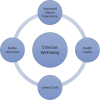A team without a name: emergency medicine recognition and its impact on working conditions and well-being
- PMID: 40314806
- PMCID: PMC12411600
- DOI: 10.1007/s00063-025-01275-8
A team without a name: emergency medicine recognition and its impact on working conditions and well-being
Abstract
Emergency medicine (EM) has evolved significantly over the past 50 years, transitioning from a focus on acute injuries and illnesses to include primary and specialty care, disaster response, and social issues. To date, nearly 60 countries have officially recognized EM as a medical specialty. However, growing patient demands, healthcare staff shortages, and an aging population have strained emergency departments, worsening working conditions for EM professionals and compromising patient care. To address these challenges, formal recognition of EM as a specialty is crucial.As a specialty, EM offers significant benefits. It improves patient outcomes by ensuring structured, standardized training that equips specialists with the skills to manage acute conditions such as trauma, stroke, and myocardial infarction. Countries with recognized EM specialties have reported reduced morbidity and mortality and enhanced healthcare resilience during crises like pandemics and mass casualty events. Additionally, professional recognition aids in recruitment, retention, and reducing burnout among EM practitioners by establishing clear career pathways. Furthermore, it ensures specific paraclinical training in areas such as patient flow, and it strengthens healthcare systems. However, despite these benefits, challenges remain. Resource diversion from primary care, increased healthcare costs, and the initial investment required for training programs are potential drawbacks to EM specialty recognition. Achieving EM recognition will require a strategic collaborative approach, focusing on education, professional support, and collaboration across healthcare sectors.
Die Notfallmedizin hat sich in den letzten 50 Jahren deutlich weiterentwickelt – mit Verlagerung des bisherigen Fokus auf akute Verletzungen und Erkrankungen zur aktuellen Einbeziehung von Primär- und spezialisierter Versorgung, des Katastrophenschutzes und sozialer Probleme. Steigende Patientenzahlen, Personalmangel im Gesundheitswesen und eine alternde Bevölkerung führen jedoch zu einer Überlastung der Notaufnahmen, was die Arbeitsbedingungen für das Notfallpersonal verschlechtert und die Patientenversorgung beeinträchtigt. Um diese Herausforderungen zu bewältigen, ist die formale Anerkennung der Notfallmedizin als Fachgebiet, wie sie heute in fast 60 Ländern erfolgt ist, entscheidend. Als Fachgebiet bietet die Notfallmedizin Vorteile. So werden die Ergebnisse für die Patienten durch strukturierte, standardisierte Ausbildung verbessert, welche die Experten mit den Fähigkeiten ausstattet, akute Zustände wie Trauma, Schlaganfall und Myokardinfarkt zu versorgen. In Ländern mit Notfallmedizin als anerkanntem Fachgebiet wurde über eine verminderte Morbidität und Mortalität sowie verstärkte Resilienz im Gesundheitswesen während Krisen wie Pandemien und Massenanfall von Verletzten dokumentiert. Allerdings bleiben trotz dieser Vorteile Herausforderungen bestehen. Die Ressourcenumleitung von der Primärversorgung, gestiegene Gesundheitsversorgungskosten und die anfängliche Investition, die für die Ausbildungsprogramme erforderlich ist, sind potenzielle Hindernisse für die Anerkennung der Notfallmedizin als Fachgebiet. Das Erreichen der Anerkennung der Notfallmedizin als Fachgebiet erfordert einen strategischen, kooperativen Ansatz mit dem Fokus auf Ausbildung, professionelle Unterstützung und gesundheitssektorübergreifende Zusammenarbeit.
Keywords: Emergency medical services; Empowerment; Medical specialty; Primary care; Psychosocial risk.
© 2025. The Author(s).
Conflict of interest statement
Declarations. Conflict of interest: M.G. Kemnitz, E.-M. Lupan-Muresan, F. Somville, B. Barcella, N. Shopen, M. de los Angeles López Hernández and E.P. Heymann declare that they have no competing interests. For this article no studies with human participants or animals were performed by any of the authors. All studies mentioned were in accordance with the ethical standards indicated in each case.
Figures
References
-
- (2021) National Center for Health Statistics. Health, United States, 1997–2019: table EDAd. Emergency department visits within the past 12 months among adults aged 18 and over, by selected characteristics: United States, selected years 1997–2019. Hyattsville, MD. https://www.cdc.gov/nchs/hus/data-finder.htm
Publication types
MeSH terms
LinkOut - more resources
Full Text Sources
Miscellaneous




